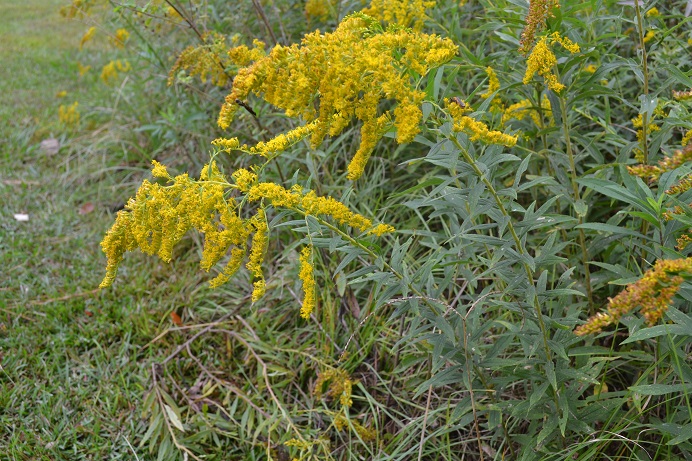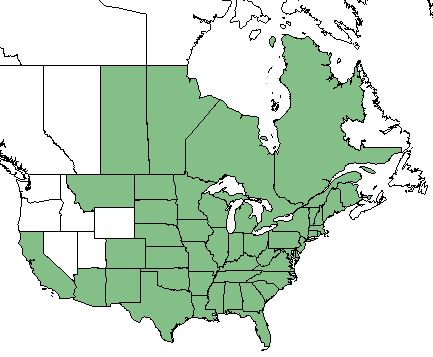Difference between revisions of "Solidago altissima"
| Line 38: | Line 38: | ||
<!--===Seed bank and germination===--> | <!--===Seed bank and germination===--> | ||
<!--===Fire ecology===--> <!--Fire tolerance, fire dependence, adaptive fire responses--> | <!--===Fire ecology===--> <!--Fire tolerance, fire dependence, adaptive fire responses--> | ||
| − | + | ||
| − | + | ===Pollination=== | |
| + | ''S. altissima'' attracts birds, butterflies, and a large number of native bees.<ref name="Ladybird"/> | ||
| + | |||
| + | ===Use by animals=== <!--Herbivory, granivory, insect hosting, etc.--> | ||
| + | |||
<!--==Diseases and parasites==--> | <!--==Diseases and parasites==--> | ||
Revision as of 17:08, 18 January 2018
| Solidago altissima | |
|---|---|

| |
| Photo by Kevin Robertson | |
| Scientific classification | |
| Kingdom: | Plantae |
| Division: | Magnoliophyta - Flowering plants |
| Class: | Magnoliopsida - Dicots |
| Order: | Asterales |
| Family: | Asteraceae |
| Genus: | Solidago |
| Species: | S. altissima |
| Binomial name | |
| Solidago altissima L. | |

| |
| Natural range of Solidago altissima from USDA NRCS Plants Database. | |
Common Name(s): tall goldenrod; Great Plains tall goldenrod; southern tall goldenrod;[1] Canada goldenrod;[2] Canadian goldenrod; late goldenrod[3]
Contents
Taxonomic Notes
Varieties: S. altissima var. altissima; S. altissima var. pluricephala;[1][2] S. altissima var. gilvocanescens;[1] S. altissima var. procera[2]
Synonym(s): S. canadensis var. scabra; S. hirsutissima;[1][2] S. pruinosa; S. canadensis var. gilvocanescens;[1] S. lunellii[2]
Description
Solidago altissima is a dioecious perennial forb/herb.[2] This plant is rough, erect, and produces small yellow flowers that are arranged along upper side of branches, producing a plume. It reaches heights of 3-6 ft (0.91-1.83 m).[3]
Distribution
This species is found in all of the lower 48 United States, excluding Washington, Oregon, Nevada, Utah, Idaho, and Wyoming. It also occurs in the Canadian provinces of Saskatchewan, Manitoba, Ontario, Quebec, and New Brunswick.[2]
Ecology
Habitat
S. altissima is found in roadsides,[1][3] fields, disturbed areas,[1] thickets, prairies, and open woods. It prefers moist to dry soils composed of clay, clay loam, medium loam, sandy loam, sandy and caliche.[3]
Phenology
Flowering occurs from August through November.[1][4]
Pollination
S. altissima attracts birds, butterflies, and a large number of native bees.[3]
Use by animals
Conservation and Management
Cultivation and restoration
Photo Gallery
References and notes
- ↑ 1.0 1.1 1.2 1.3 1.4 1.5 1.6 1.7 Weakley AS (2015) Flora of the Southern and Mid-Atlantic States. Chapel Hill, NC: University of North Carolina Herbarium.
- ↑ 2.0 2.1 2.2 2.3 2.4 2.5 2.6 USDA NRCS (2016) The PLANTS Database (http://plants.usda.gov, 118 January 2018). National Plant Data Team, Greensboro, NC 27401-4901 USA.
- ↑ 3.0 3.1 3.2 3.3 3.4 Plant database: Solidago altissima. (18 January 2018) Lady Bird Johnson Wildflower Center. URL: https://www.wildflower.org/plants/result.php?id_plant=SOAL6
- ↑ Nelson G (18 January 2018) PanFlora. Retrieved from gilnelson.com/PanFlora/